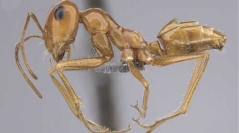Abstract. The Sultanate of Oman is a country on the southeastern corner of the Arabian Peninsula, near the intersection of the Afrotropical, Palaearctic, and Indomalayan biogeographic realms. We surveyed ants at 18 sites between 16 and 22 November 2017 using beating sheets, hand picking, Malaise traps, sifting trays, sweeping net, and light traps on the coastal plains and monsoon slopes of Dhofar Governorate in southwest Oman, an area that is relatively verdant due to its exposure to monsoons between June and September. We collected 37 ant species, including 11 species recorded for the first time from Oman: Camponotus diplopunctatus Emery, 1915, Cardiocondyla minutior Forel, 1899, Cardiocondyla wroughtonii (Forel, 1890), Carebara arabica (Collingwood & van Harten, 2001), Leptanilla islamica Baroni Urbani, 1977, Monomorium clavicorne André, 1881, Monomorium floricola (Jerdon, 1851), Monomorium sahlbergi Emery, 1898, Strumigenys membranifera Emery, 1869, Anochetus sedilloti Emery, 1884, and Hypoponera ragusai (Emery, 1894). In total, 130 ant species are now known from Oman, including 53 from Dhofar. The known ants of Dhofar are primarily of Afrotropical origin (23 species, 43%), followed by Palearctic (20 species, 38%), and Indomalayan (4 species, 8%), and a single species from both the Malagasy and Neotropical Regions (1%). Five species (9%) are apparently endemic to Dhofar, Lepisiota dhofara Collingwood & Agosti, 1996, Lepisiota elbazi Sharaf & Hita Garcia, 2020, Crematogaster jacindae Sharaf & Hita Garcia, 2019, Meranoplus mosalahi Sharaf, 2019, and Nesomyrmex micheleae Sharaf, 2020. The zoogeography of the Omani ant fauna reflects a clear dominance of faunal elements from the Palearctic Region (68 species, 53%) followed by Afrotropical faunal elements (45 species, 34%), and five species that are broadly spread throughout both the Palearctic and the Afrotropical Regions (4%). There are nine species (6%) from the Indomalayan Region, two species from the Neotropical Region (2%), T. melanocephalum, C. emeryi, and a single species Ph. megacephala (1%) from the Malagasy Region. The number of endemic species (15 species, 12%) is relatively low compared to the large geographical area of Oman and the broad diversity of habitats that characterizes the country.


 European Journal of Taxonomy
838 (1) - Pages 1-106
European Journal of Taxonomy
838 (1) - Pages 1-106